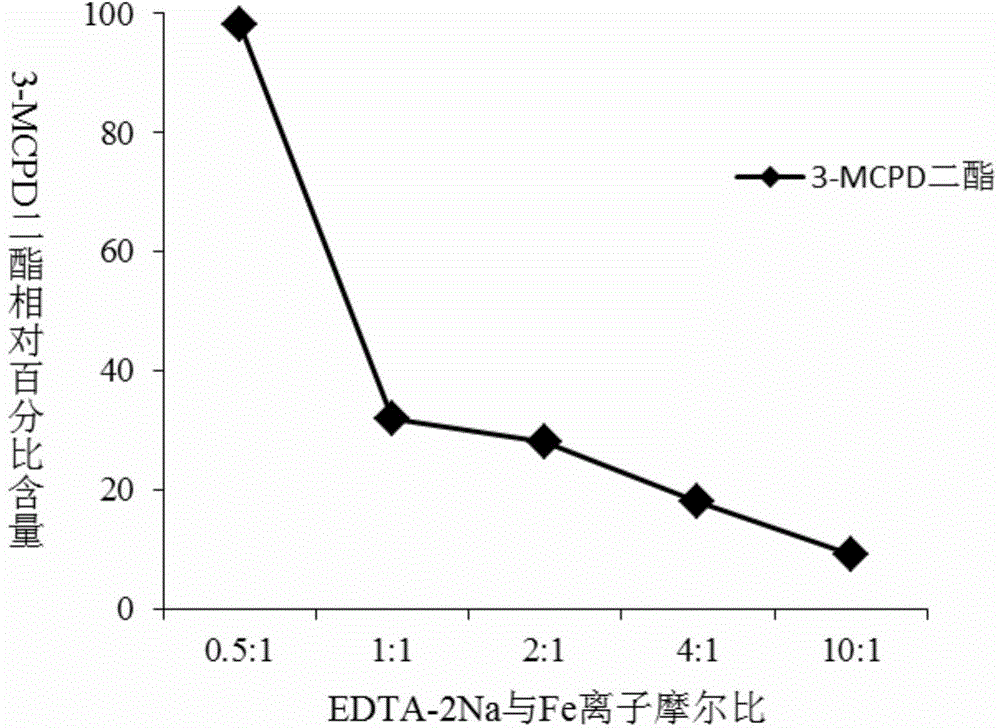Method for reducing 3-chlorine-1,2-propylene glycol ester during grease processing
A technology of oil processing and propylene glycol ester, which is applied in the direction of fat oil/fat refining and fat production, and can solve the problems of decolorization and deodorization effects such as decline, increase, and incomplete degradation
- Summary
- Abstract
- Description
- Claims
- Application Information
AI Technical Summary
Problems solved by technology
Method used
Image
Examples
Embodiment 1
[0058] Add 2 mL of ferric chloride into 5 mL of glyceryl tristearate solution, the concentration of the solution is 0.5 mg / mL, and the solvent is n-hexadecane. After ultrasonic oscillation for 30 minutes, a series of different contents of EDTA-2Na (1.2, 2.3, 4.6, 9.2, 23.0 mg) were added, which, together with FeCl 3 The molar ratios are 0.5:1, 1:1, 2:1, 4:1, 10:1, respectively. The control group did not add such as EDTA-2Na. The reaction system was continuously stirred at 120° C. for 20 minutes, and then cooled to room temperature. The reaction solution was diluted with a 50-fold methanol:isopropanol=1:1 (v / v) solution, filtered and analyzed by UPLC-Q-TOF MS.
[0059] The content of the 3-MCPD diester that above-mentioned experiment generates is as follows figure 1 shown. The experimental results showed that with the increase of the ratio of EDTA-2Na and ferric chloride, the content of 3-MCPD ester formed in the reaction product decreased significantly. When EDTA-2Na and ...
Embodiment 2
[0061] 400mg FeCl 3 Add to 80g refined palm oil, ultrasonic treatment for 5min, then add 0.938g and 4.655g EDTA-2Na respectively, the blank group does not add EDTA-2Na. Then under the protection of nitrogen, the pressure was maintained at 5 mbar with an oil pump, and the mixture was heated at 240° C. for 1 h. After the reaction was completed, the nitrogen gas was continuously fed. When the temperature was lower than 100°C, the pressure could return to normal atmospheric pressure. Take 10 μL of the sample and dilute it 100 times with isopropanol, filter it through a 0.2 μm GHP filter membrane, and detect the concentration of 3-MCPD ester (detection Method is identical with embodiment 1).
[0062] The content of the 3-MCPD ester that above-mentioned experiment generates is as follows figure 2 shown. With the increase of the ratio of EDTA-2Na and ferric chloride, the content of 3-MCPD ester in the reaction product decreased significantly.
PUM
 Login to View More
Login to View More Abstract
Description
Claims
Application Information
 Login to View More
Login to View More - R&D
- Intellectual Property
- Life Sciences
- Materials
- Tech Scout
- Unparalleled Data Quality
- Higher Quality Content
- 60% Fewer Hallucinations
Browse by: Latest US Patents, China's latest patents, Technical Efficacy Thesaurus, Application Domain, Technology Topic, Popular Technical Reports.
© 2025 PatSnap. All rights reserved.Legal|Privacy policy|Modern Slavery Act Transparency Statement|Sitemap|About US| Contact US: help@patsnap.com


